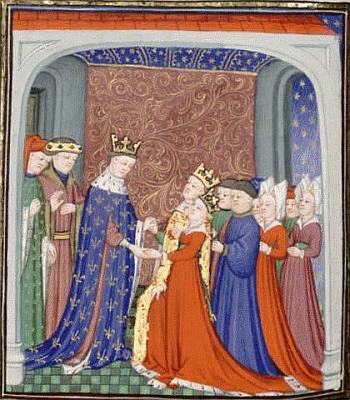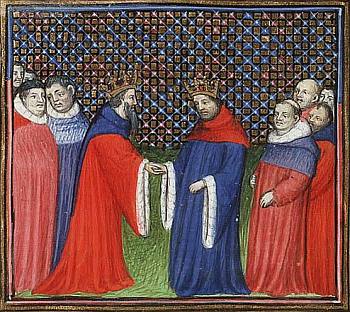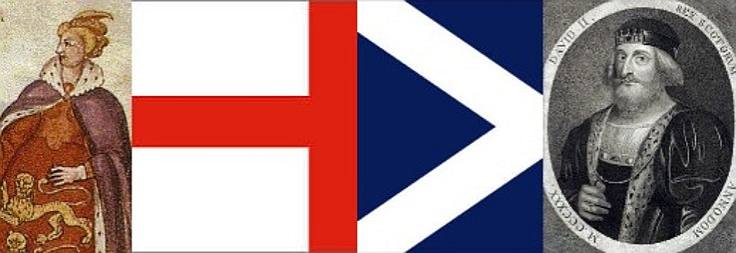17 July 1328
David II of Scotland, 1324 – 1371
married
Joanna of England (known as Joan of the Tower), 1321 – 1362
Berwick’s strategic importance to both Scotland and England and the wars between the two nations are well documented. However the importance of the wedding between Robert the Bruce’s son David and Joanna, the sister of King Edward III, in Berwick in 1328 is less well known. Why it came about and why it was important can be seen in the following account by author and television presenter Bamber Gascoigne from his History World website.
Bannockburn and after: 1314-1328

David II and his wife meet Philip VI of France; from a 15th century manuscript of Froissart’s Chronicles. Image: Wikimedia Commons, CC-BY-SA-2.0.
By 1314 Bruce’s slow campaign of guerrilla warfare and attrition has brought into his hands all the English strongholds in Scotland except Stirling. The Scottish threat to this great castle brings Edward II north to its defence.
On June 24 Bruce, with only about 8000 men, is confronted by an English army of double that size. But he chooses his ground well – an area of boggy turf about two miles south of Stirling, with a narrow front and the Bannockburn to cut off the enemy’s retreat. The English cavalry flounder in the face of Scottish foot soldiers armed with spears. The day is a resounding success for Scotland, bringing rich rewards in prestige, booty and ransom.
In the years after Bannockburn, Bruce continually raids south across the border into England. And he extends his campaign against the English by sending Edward Bruce, his only surviving brother, to attack them in 1315 in Ireland.
The Irish campaign ends in 1318 with the death of Edward Bruce, but in the north of England Robert Bruce’s aggressive tactics go unchecked. Edward II marches north with large armies in 1319 and again in 1322, but achieves nothing. After his death, in 1327, the English are ready to come to terms.
At Edinburgh, in March 1328, a treaty is agreed – and is ratified at an English parliament in Northampton the following month. The Scots are to pay £20,000 in reparation for damage done in the northern counties of England, but otherwise the concessions are all to their benefit. Above all it is agreed that Scotland shall ‘remain to Robert king of Scots and his heirs and successors free and divided from the kingdom of England, without any subjection, right of service, claim or demand’.

David II acknowledges Edward III as his feudal lord; from a 15th century manuscript of Froissart’s Chronicles (Koninklijke Bibliotheek, The Hague: ms.72 A 25, folio 187r). Image: Wikimedia Commons, CC-BY-SA-2.0.
As a token for a better future, Bruce’s 4-year-old son David is married in July, in Berwick, to Joanna, the 7-year-old sister of the new English king, Edward III.
The agreements of 1328 raise the hope that Scotland is due at last for a period of calm. But the death of Robert the Bruce in 1329 brings his son David, now aged five, to the throne. The English instinct to meddle in Scottish affairs is revived. Edward, the son of John de Balliol (who has died in 1314), is encouraged to stake a claim to his father’s throne. Scotland is again plunged into war.
Robert the Bruce’s son, David II, spends much of his reign in exile or in captivity. But he is still on the throne when he dies, childless, in 1371. The future of the royal house lies with the descendants of his elder sister, Marjorie. She married, in 1315, one of Scotland’s hereditary stewards.
Source: Bamber Gascoigne. “History of Scotland”, HistoryWorld. From 2001, ongoing.
Banner images:
Joanna Queen of Scotland: Wikimedia Commons.
David II of Scotland, by Edward Harding, published by Isaac Herbert, after Jamesson
stipple engraving, published 1797. National Portrait Gallery, NPG D23890.

This work is licensed under a Creative Commons Attribution 4.0 International License

